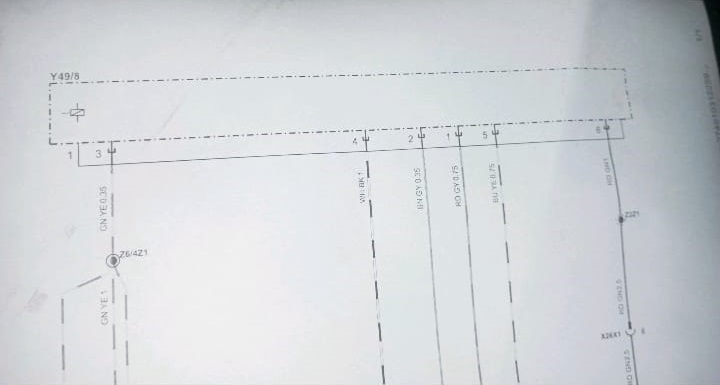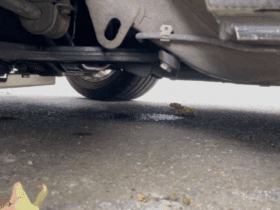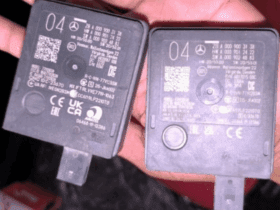Table of Contents
Engine Light On: Mercedes-Benz C300 Case Study (M274 Engine)
Introduction
Seeing the engine light on in your Mercedes-Benz C300 can quickly cause concern. This dashboard warning may signal something minor, like a loose gas cap, or more serious engine issues requiring immediate repair. For owners of the C300 with the M274 engine, diagnosing the light correctly is essential to protect both performance and reliability.
In this case study, we’ll walk through a real-world diagnostic process where the engine light was triggered by a faulty cam actuating solenoid (Y/49). Using step-by-step troubleshooting with Mercedes XENTRY software, visual inspections, and electrical testing, we’ll show how the root cause was identified and repaired.
This article is part of our Mercedes Check Engine Light – Complete Troubleshooting Hub, where you can explore more case studies and guides.
Vehicle Case Overview
- Model: Mercedes-Benz C300
- Engine: M274 turbocharged petrol
- Complaint: Engine light on (steady, not flashing)
The customer reported no severe drivability issues but wanted the cause investigated immediately.
Step-by-Step Diagnosis
Step 1: Diagnostic Scan with XENTRY
The first step was running a guided test using XENTRY, Mercedes-Benz’s diagnostic software. The scan revealed the following fault code:
- P261511 – The output signal for the position of the camshaft has a short circuit to ground.
This pointed toward the cam actuating solenoid (Y/49).

Step 2: Visual Inspection
The solenoid was visually inspected. Findings included:
- – Oil contamination inside the socket connection.
- – Cleaning was attempted, but the fault code returned, indicating contamination was not the sole issue.

Step 3: Electrical Checks
A multimeter was used to measure voltage and continuity on the solenoid’s input connections.
- – Results: Voltage and continuity appeared normal.
- – No clear short to ground was detected.
This suggested the fault was internal to the solenoid.



Step 4: Checking Camshaft Sensors
Both camshaft Hall sensors were tested to rule out timing-related sensor errors.
- – Each sensor’s positive, negative, and 5V signals were within specification.
- – Sensors were ruled out as the cause.

Step 5: Conclusive Identification
After eliminating wiring and sensors, focus returned to the Y/49 cam actuating solenoid. The combination of:
- – Persistent fault code
- – Oil contamination in the socket
- – And normal sensor readings
…confirmed the solenoid itself was defective.
Repair Process
Solution: Replacing the Y/49 Cam Actuating Solenoid
- 1. Battery disconnected to prevent electrical surges.
- 2. Old solenoid removed from the cylinder head assembly.
- 3. New OEM solenoid installed, ensuring proper sealing to avoid future oil contamination.
- 4. Diagnostic reset performed → cleared stored fault codes.
- 5. Engine tested with ignition cycles and a short road test.
Result: Fault code disappeared, CEL switched off, and engine returned to normal operation.
Symptom – Cause – Fix Table
| Symptom | Likely Cause | Repair Solution |
|---|---|---|
| CEL with code P261511 | Cam actuating solenoid short circuit | Replace solenoid Y/49 |
| CEL + oil contamination | Oil leaking into solenoid socket | Clean or replace solenoid + connector |
| CEL + misfire or hesitation | Camshaft sensor fault | Replace camshaft Hall sensor |
| CEL steady with no drivability issue | Loose or faulty gas cap | Replace/tighten gas cap |
Preventive Tips
- – Inspect solenoid connections regularly for oil or moisture.
- – Perform electrical checks during servicing to catch weak solenoids early.
- – Never ignore the CEL – even if the car runs fine, small issues can escalate.
- – Use OEM parts for replacements to ensure proper fit and longevity.
FAQs: Engine light on
Q: What are common reasons for the engine light to come on in a C300?
- – Faulty O₂ sensor → affects emissions and fuel economy.
- – Catalytic converter issues → loss of efficiency.
- – Mass airflow (MAF) sensor fault → rough idle, poor performance.
- – Ignition coil or spark plug misfires.
- – Simple issues like a loose gas cap.
Q: Can I continue driving with the engine light on?
- – Steady light: Usually safe for short trips, but diagnosis should be done ASAP.
- – Flashing light: Indicates misfire or serious fault → stop immediately to avoid engine or catalytic converter damage.
Q: How do I diagnose the CEL in a Mercedes-Benz C300?
- – Use an OBD-II scanner or Mercedes-specific XENTRY system.
- – Retrieve fault codes → perform visual inspection → carry out electrical checks → confirm with guided tests.
Q: Will the CEL reset itself after the issue is fixed?
Yes, in many cases the light turns off after several drive cycles once the fault is resolved. However, clearing codes with a scanner provides immediate confirmation.
Q: Are there M274-specific issues that trigger the CEL?
Yes. The Y/49 cam actuating solenoid is a known weak point. Timing chain wear and cam/crankshaft position sensor faults are also common triggers.
Lessons Learned
- 1. Thorough diagnostics save money. The customer avoided unnecessary replacement of sensors or wiring by confirming the solenoid fault first.
- 2. Oil contamination is a red flag. Even if connections look fine, oil intrusion often points to solenoid failure.
- 3. CEL doesn’t always mean major damage. In this case, a relatively simple solenoid swap restored full function.
Conclusion
In this Mercedes-Benz C300 case study, the engine light on was caused by a faulty Y/49 cam actuating solenoid. Systematic diagnostics scanning codes, inspecting connectors, testing sensors, and finally replacing the solenoid resolved the issue and turned off the warning light.
For C300 owners, this shows why addressing CELs promptly is critical: small issues, when ignored, can escalate into costly repairs.
For more detailed guides, visit:
Mercedes Check Engine Light – Complete Troubleshooting Hub
Author Bio
Written by Mercedes Expert
With years of hands-on experience diagnosing and repairing Mercedes-Benz systems, he brings technical depth and practical case studies to help car owners, technicians, and enthusiasts troubleshoot complex automotive issues. His work focuses on clear repair guides, OEM-level procedures, and knowledge-sharing to empower both professionals and drivers.
Last update: September 2025
— Salim, Mercedes Expert
Independent specialist in Mercedes-Benz diagnostics, CAN Bus analysis, troubleshooting case studies, and EV systems.







Leave a Reply